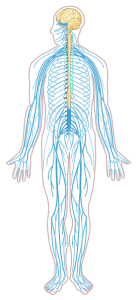University of Hawai‘i at Mānoa Food Science and Human Nutrition Program and Human Nutrition Program
The human brain (which weighs only about 3 pounds, or 1,300 kilograms) is estimated to contain over one hundred billion neurons. Neurons form the core of the central nervous system, which consists of the brain, spinal cord, and other nerve bundles in the body. The main function of the central nervous system is to sense changes in the external environment and create a reaction to them. For instance, if your finger comes into contact with a thorn on a rose bush, a sensory neuron transmits a signal from your finger up through the spinal cord and into the brain. Another neuron in the brain sends a signal that travels back to the muscles in your hand and stimulates muscles to contract and you jerk your finger away. All of this happens within a tenth of a second. All nerve impulses travel by the movement of charged sodium, potassium, calcium, and chloride atoms. Nerves communicate with each other via chemicals built from amino acids called neurotransmitters. Eating adequate protein from a variety of sources will ensure the body gets all of the different amino acids that are important for central nervous system function.
Figure 2.14 The Central Nervous System

The brain’s main fuel is glucose and only in extreme starvation will it use anything else. For acute mental alertness and clear thinking, glucose must be systematically delivered to the brain. This does not mean that sucking down a can of sugary soda before your next exam is a good thing. Just as too much glucose is bad for other organs, such as the kidneys and pancreas, it also produces negative effects upon the brain. Excessive glucose levels in the blood can cause a loss of cognitive function, and chronically high blood-glucose levels can damage brain cells. The brain’s cognitive functions include language processing, learning, perceiving, and thinking. Recent scientific studies demonstrate that having continuously high blood-glucose levels substantially elevates the risk for developing Alzheimer’s disease, which is the greatest cause of age-related cognitive decline.
The good news is that much research is directed toward determining the best diets and foods that slow cognitive decline and maximize brain health. A study in the June 2010 issue of the Archives of Neurology reports that people over age 65 who adhered to diets that consisted of higher intakes of nuts, fish, poultry, tomatoes, cruciferous vegetables, fruits, salad dressing, and dark green, and leafy vegetables, as well as a lower intake of high-fat dairy products, red meat, organ meat, and butter, had a much reduced risk for Alzheimer’s disease.[1]
Other scientific studies provide supporting evidence that foods rich in omega-3 fatty acids and/or antioxidants provide the brain with protection against Alzheimer’s disease. One potential “brain food” is the blueberry. The protective effects of blueberries upon the brain are linked to their high content of anthocyanins, which are potent antioxidants and reduce inflammation. A small study published in the April 2010 issue of the Journal of Agricultural and Food Chemistry found that elderly people who consumed blueberry juice every day for twelve weeks had improved learning and memorization skills in comparison to other subjects given a placebo drink.[2]
However, it is important to keep in mind that this was a short-term study. Blueberries also are high in manganese, and high intake of manganese over time is known to have neurotoxic effects. Variety in the diet is perhaps the most important concept in applied nutrition. More clinical trials are evaluating the effects of blueberries and other foods that benefit the brain and preserve its function as we age.
Learning Activities
Technology Note: The second edition of the Human Nutrition Open Educational Resource (OER) textbook features interactive learning activities. These activities are available in the web-based textbook and not available in the downloadable versions (EPUB, Digital PDF, Print_PDF, or Open Document).
Learning activities may be used across various mobile devices, however, for the best user experience it is strongly recommended that users complete these activities using a desktop or laptop computer and in Google Chrome.
- Gu Y, Nieves JW, et al. (2010). Food Combination and Alzheimer Disease Risk: A Protective Diet. Archives of Neurology, 67(6), 699–706. https://www.ncbi.nlm.nih.gov/pubmed/20385883 ↵
- Krikorian R, Shidler MD, et al. (2010). Blueberry Supplementation Improves Memory in Older Adults. Journal of Agricultural and Food Chemistry, 58(7). https://www.ncbi.nlm.nih.gov/pubmed/20047325 ↵
The organ system that includes the brain and spinal cord responsible for sensing changes in the external environment and creating a reaction to them.
A chemical released from one end of a nerve cell that travels across the gap (synapse) between one cell and the next to either stimulate or inhibit its transmission of a nerve impulse. Neurotransmitters are the chemicals responsible for transmitting nerve signals between nerve cells.
A 6-carbon monosaccharide that is the major carbohydrate used to provide energy in the body.
A group of tissues that performs a specialized function.
A disease that results in an irreversible loss of mental function.

